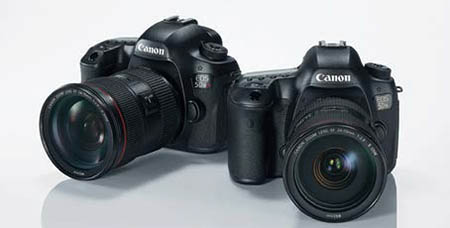NAB 2015: Canon Addresses 4K Imaging Challenges

Canon recently introduced the EOS 5DS and EOS 5DS R DSLR cameras, with 50 megapixel sensors.
LAS VEGAS—Larry Thorpe, senior fellow for Canon U.S.A.’s Imaging Technologies & Communications Group, Professional Engineering & Solutions Division, has been listening to the company’s camera and lens customers and has discerned the current trends in cameras and lenses.
“I see three major format sizes dictating most of what is being done with lenses and cameras today: the large format, Super35. There’s no question that’s very hot,” he said. “And good old 2/3-inch is rock-solid in applications like sports and still a lot of broadcast studios, and some ENG and EFP. And then down in the small format, the 1/3-inch and variants on that, we see it still briskly growing, especially in broadcast news.”
LAYING THE GROUNDWORK
Canon is a big player in lenses for all three of the camera types Thorpe mentioned, but only makes digital video cameras in the large format and 1/3-inch sensor arenas. Chuck Westfall, advisor to Canon U.S.A.’s Strategic Research & Development, Future Product & Solution Plan Division, spoke of the feedback he’s gotten in line with those cameras.
“What’s really been encouraging for me to see in the last year is the great penetration of the Cinema EOS product line into Hollywood,” Westfall said. “It’s shown up not only on the major motion pictures—mostly as a B camera—but also in independent films and documentaries.” Westfall estimated that fully one-third of all the movies shown at this year’s Sundance Festival were shot with Cinema EOS cameras. “The groundwork that we were doing the past couple of years has really helped us gain a lot of traction in the market.”
Canon has introduced three new DSLRs in recent months: the EOS 5DS and EOS 5DS R—which pushed open a new era of still camera resolution with 50 megapixel sensors—and the EOS 7D Mark II, with a host of still photography tools such as the ability to shoot 20-megapixel still photos at 10 frames per second. “Of course that does not have much bearing on the video capabilities,” said Westfall, “but we’re seeing that there’s a tremendous level of interest in these cameras as general purpose tools that can do more in terms of high resolution for stills, while maintaining full HD capability.”
4K CHALLENGES
New life has been breathed into the 2/3-inch lens market by a quite recent development in 4K cameras. Large format sensor cameras have largely proved unworkable for traditional stadium sports coverage due to the sheer size of zoom lenses that would duplicate the large zoom range glass used for HD sports coverage, as well as lack of depth of field. Last year’s NAB Show saw two 2/3-inch 4K cameras introduced, and Thorpe expects to see more at this year’s show.
Get the TV Tech Newsletter
The professional video industry's #1 source for news, trends and product and tech information. Sign up below.
“We at Canon have been working with three of those manufacturers,” Thorpe said. “They came to us and I’m sure they went to other optical manufacturers, because they said ‘we’re going to commit to making 2/3-inch 4K cameras and we’ve got to have lenses.’”
Asked how he thinks current top-of-the-line long zoom lenses would perform when mounted on a three sensor 2/3-inch camera, he reported: “Surprisingly good. And in fact we’ve done some testing with some of the entities out there who are very interested, some of the mobile truck companies and some of the networks, where we’ve taken the latest generation [which is fourth generation by the way] high-definition lenses. And to the surprise of all parties, the camera manufacturers, ourselves and the customer bases we’ve been working with, everybody was very impressed at just how good the 4K was.
“That said—especially in the discussions with our engineers and the respective engineers at the camera manufacturers—as they delved deeper we were asked: ‘Could we do this, could we improve that,’ and that’s the sort of development activity that’s been going on for the past eight or nine months.”
Though most of the talk about these 2/3-inch 4K cameras and lenses has centered around stadium sports production, some producers of certain genres of television shows are looking to that same technology to preserve the deeper depth of field they’ve become used to with their 2/3-inch HD equipment.
Both Westfall and Thorpe see the upcoming NAB Show as one of excitement and surprises on the 4K front. “When you start talking about the challenges of being able to deliver 4K content,” said Westfall, “you get involved with all these emerging standards that are just now starting to be ratified, and there’s still a lot of work to be done.”
Thorpe agreed, adding, “I think NAB will show a lot of the missing pieces of the total infrastructure of a 4K ecosystem. There are a lot of companies working on various elements of that, and while cameras and lenses have been proliferating, recording and storage and switching are all being worked out. Related to that, there’s been a surge of interest in the IP infrastructure for broadcast. A driver for that, of course, has been the greater data rates and bandwidths demanded by 4K. I’m expecting to see an awful lot of this at NAB.”
Canon will be in booths C3628 and C4325 in the Central Hall of the LVCC.
